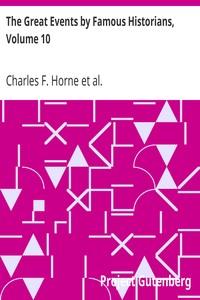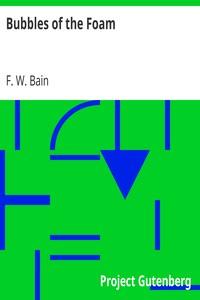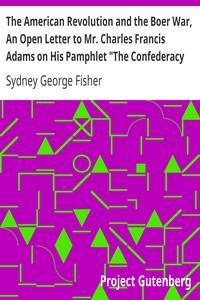|
|
Read this ebook for free! No credit card needed, absolutely nothing to pay.Words: 150839 in 27 pages
This is an ebook sharing website. You can read the uploaded ebooks for free here. No credit cards needed, nothing to pay. If you want to own a digital copy of the ebook, or want to read offline with your favorite ebook-reader, then you can choose to buy and download the ebook.

: The Great Events by Famous Historians Volume 10 by Horne Charles F Charles Francis Editor Johnson Rossiter Editor Rudd John LL D Editor - World history@FreeBooksTue 06 Jun, 2023 ," she told the two deputies, "they shall be banished out of Scotland, albeit they preached as truly as ever did St. Paul." When they reminded her of her previous promises, she replied in words that were never forgotten, and which her grandson, James VI, recalled and laid to heart in his own dealings with his subjects. "It became not subjects," she said, "to burden their princes further than it pleaseth them to keep the same." For a time, however, she consented to stay further action against the preachers. But, if she were to carry out the task she had undertaken, she must sooner or later make trial of her strength against what had now become actual rebellion. In Perth, Dundee, and Montrose the Protestant preachers, with the approval and countenance of the constituted authorities, openly proceeded with their work of spreading their new opinions. At length the Regent took the step which was to be the beginning of the end of the Catholic Church in Scotland. She summoned the preachers to appear before her at Stirling on May 10th, and on this occasion it was recognized by both parties that the moment for decisive action had come. To be ready for all contingencies, a numerous body of Protestant gentlemen from Angus and the Mearns, all, it is specially noted, "without armor," took up their quarters at Perth, where they were immediately joined by another contingent from Dundee. With this last body came John Knox, who on May 20th had finally returned to his native country. All through their contest with the Regent, the Protestant leaders took up the position that they were acting in strict accordance with the law of the land. With the formidable following now at their back, they might have marched on Stirling and gained a temporary advantage by their show of strength. What they actually did was to send Erskine of Dun to the Regent to lay their demands once more before her. As she was not yet in a position to enforce her will, she again agreed to postpone action against the preachers. It was the misfortune of her position from the beginning of the struggle that Mary of Lorraine was driven to subterfuges which made impossible any permanent understanding with her discontented subjects; and it was of evil omen for the success of her policy that she now allowed herself to commit a serious breach of faith. In the teeth of her promise to Erskine, she proclaimed the preachers as outlaws when they failed to appear at Stirling on the day appointed for their trial. The news of the Regent's breach of faith was the immediate occasion of the first stroke in the Scottish Reformation. The day after the outlawry John Knox preached a sermon in the parish church of Perth, his theme being the idolatries of Rome, and the duty of Christian men to put an end to them. At the close of the sermon, when the majority of the audience had left the church, a priest proceeded to celebrate mass. A forward boy made a protesting remark; the priest struck him; the boy retaliated by throwing a stone which broke an image, and immediately the church was in an uproar. In a few moments not "a monument of idolatry" was left in the building. The news of these doings spread through the town, and the "rascal multitude" took up the work. There had been old quarrels between the town and the religious orders; and so early as 1543 a violent assault had been made on the Blackfriars' monastery. But on the present occasion the work done was at once more extensive and more thorough. The main onslaught was directed toward the monasteries of the Dominicans and the Franciscans and the Charterhouse Abbey; and within two days, says Knox, "the walls only did remain of these great edifications." But the time demanded deeds more than words. With a force of about eight thousand French and Scots, D'Oysel, the Regent's chief adviser, advanced to Auchterarder, some twelve miles from Perth. With this formidable force behind her, the Regent naturally expected that her rebellious subjects would be disposed to abate their demands. To learn what terms they would now be willing to accept, she sent to Perth the lord James Stewart, Lord Sempill, and the Earl of Argyle. They were told that the town would be surrendered if assurance were given of freedom of worship and security to the worshippers. As a reply to these demands, the Regent despatched the lyon king-of-arms to make proclamation that all should "avoid the toune under pane of treasone." At this moment, however, the Earl of Glencairn, at the head of a body of two thousand five hundred Ayrshire Protestants, made his way to within six miles of Perth. Thus checkmated, the Regent was again driven to a compromise; and on the conditions that she should quarter no French troops in the town, and grant perfect freedom of worship, the gates were at length thrown open to her. Thus closed the first act of the drama of the Scottish Reformation. This good understanding was of short duration. Again the action of the Regent gave rise to an accusation of broken pledges. She kept to the letter of the late compact, but she evaded its spirit. She did not quarter French troops in the town, but she occupied it with Scottish soldiers in French pay, and, in further disregard of her pledges, treated the Protestants with a harshness which gave rise to bitter complaint on the part of their leaders. Argyle and the lord James, the two most prominent of these leaders, had accompanied her into Perth , but, indignant at these proceedings, they secretly quitted the town and at once took action to make good their protests. Summoning the Protestant gentlemen of Angus and the Mearns to meet them in St. Andrew's on June 3d, they proceeded to that town, as the best centre of action after Perth. In St. Andrew's as in Perth it is John Knox who is again the outstanding figure. Here his preaching was attended by the same notable results. The monasteries of the Dominicans and the Franciscans were practically demolished by the mob, and with the approval of the magistrates every church in the town was stripped of its ornaments. Meanwhile the Regent had not been idle, and was now at Falkland with a force led by D'Oysel and Ch?telherault. Confident in their strength, those two leaders marched toward Cupar, with the intention of dealing with St. Andrew's. But again they discovered that they had miscalculated the resources of the insurgents. Issuing from St. Andrew's, with little over a hundred horse, Argyle and the lord James were speedily re?nforced by contingents from Lothian and Fife, which raised their numbers to above three thousand men. Thus strengthened, they took up their position on Cupar Muir, and awaited the approach of the Regent's forces. But in number these forces were now inferior to those of the enemy; and, as many of the French soldiers were Huguenots and secretly sympathized with their fellow-believers, the issue of the battle could not but be doubtful. Again, therefore, there was no alternative for the Regent but to temporize. It was agreed that there should be a truce of eight days, that the Regent's forces now in Fife should be removed from that county, and that, during the armistice, an attempt should be made to effect some permanent understanding. What the Guises meant speedily became apparent. About the middle of August a thousand French soldiers landed at Leith; and, as they were accompanied by their wives and children, the object of their coming could not be misunderstood. If the leaders of the Congregation, therefore, were not to lose all the ground they had lately gained, a time for vigorous action had again come. As had been previously concerted, they met at Stirling on September 10th and took counsel as to their further action. Here they were joined by an ally who, by his rank and his claims, was of the first importance to their cause. This was the Earl of Arran, the eldest son of the Duke of Ch?telherault, who, a few months previously, had been forced to flee from France by reason of his Protestant sympathies. The value of the new confederate was soon realized. Passing to Hamilton palace, the insurgent leaders there met the Duke himself, to whom they held out such alluring prospects that he openly identified himself with their cause. During these transactions at Hamilton, alarming news came of the doings of the Regent. It was reported that she was busily engaged in fortifying Leith--a proceeding, the Congregation maintained, in direct violation of the late treaty. Disregarding their protest, she steadily proceeded with the work; and, as she was strengthened by a new contingent of eight hundred French men-at-arms, her position by the middle of autumn was such as to excite alarm alike in Scotland and England. Again there was no arbitrament but by the sword. On October 16th the insurgent leaders entered Edinburgh with the intention of laying siege to Leith, where the Regent had taken refuge as the safest place in the kingdom. One of their earliest steps was the most audacious they had yet taken. They formally deposed Mary of Lorraine from the regency, on the ground that she had ruled as a tyrant and was betraying the country to a foreign enemy. But they soon found that they had taken a task beyond their strength. Their force amounted to but eight thousand men, most of whom were "cuntrie fellows" with no experience in war, and whose service could not extend beyond a few weeks. To this undisciplined host was opposed a garrison of three thousand trained soldiers, with the command of the sea and intrenched in a town fortified after the best military art of the time. Fortune, moreover, was against the Congregation from the first. A new instalment of one thousand pounds, secretly sent by Elizabeth, was cleverly seized by James, Earl of Bothwell, afterward the notorious helpmate of Mary Stuart. Their arms, also, met with no success. While a detachment of their troops was in pursuit of Bothwell, the enemy found their opportunity and made their way even into the streets of Edinburgh; and on November 25th the reformers sustained so severe a reverse that the capital was no longer a safe place for them. They had no money to pay the few mercenaries whom they had hired; the town was tired of them; and the earl Marischal, who had charge of the castle, held resolutely aloof. As at the close of their previous rising, the leaders held a council at Stirling to determine their future policy; before they entered on their deliberations, Knox was called upon to preach a sermon--Knox, of whom it was said that he "put more life" into those who heard him "than five hundred trumpets continually blustering" in their ears. The deliberations that succeeded took a sufficiently practical shape. Young Maitland of Lethington, who had lately deserted the Regent for the Congregation, was despatched to England with offers that might induce Elizabeth to give direct support to the cause of Protestantism in Scotland. As to their own future action, the lords made the following arrangement: Ch?telherault, Argyle, Glencairn, and the lords Boyd and Ochiltry were to make their head-quarters in Glasgow; while Arran, the lord James, the lords Rothes and Ruthven, and John Knox were to act from St. Andrew's as their centre. Their counsels at an end, they separated with the intention of reassembling at Stirling on December 16th. They had thus tried two falls with the Regent, and in both they had been worsted: the third trial of strength was to have a different ending. The Regent was not slow to follow up her advantage. She took possession of the capital two days after the Congregation had quitted it, and she tried hard, but in vain, to persuade the earl Marischal to surrender the castle. The arrival of fresh re?nforcements from France at the beginning of December enabled her to abandon her defensive policy and to take decisive measures for the suppression of revolt. On Christmas Day, while the Protestant lords were in council at Stirling, two detachments of her troops, commanded by D'Oysel, drove them precipitately from the town. Pursuing his advantage, D'Oysel despatched his troops across Stirling bridge into Fife, and he himself with another detachment crossed from Leith, apparently with the object of gaining possession of St. Andrew's. The task proved a hard one. At every step he was beset by the Scots under Argyle and the lord James. "The said Earl and Lord James," says Knox, "for twenty-one days they lay in their clothes; their boots never came off; they had skirmishing almost every day; yea, some days, from morn to even." Yet, in the teeth of all obstacles, D'Oysel steadily forced his way to within six miles of St. Andrew's, where Knox and his friends had all but abandoned hope. But unexpected deliverance was at hand. On January 23, 1560, a fleet of strange vessels appeared at the mouth of the Frith of Forth. As a French fleet had been expected for some weeks, D'Oysel concluded that his armament had come at last. He was soon undeceived. Under his eyes the strangers seized two ships bearing provisions from Leith to his own camp. The strange vessels were an advanced squadron of a fleet sent by Elizabeth to block the Frith of Forth against further succors from France. It was now D'Oysel who was in extremities; and before he found himself safe in Linlithgow he had vivid experience at once of the rigors of a Scotch winter and of the savage hate which his countrymen had come to inspire in the nation which for three centuries had called them friends and allies. Meanwhile, the mission of Maitland to the English court was about to lead to one of the most notable compacts in the national history. At Berwick-on-Tweed, the lord James Stewart, Lord Ruthven, and three other Scottish commissioners met the Duke of Norfolk and concluded a treaty which was to insure the eventual triumph of the Congregation, to make Scotland a Protestant country, and at a later day a constituent part of a Greater Britain. The treaty was in effect a bond of mutual defence against France--Elizabeth having reluctantly consented that an English army should at once enter Scotland and assist the Congregation in driving the French soldiery out of the country. While her revolted subjects were thus making strong their hands against her, fortune was otherwise deserting the cause of the Regent. A great French armament, which was to have brought over a force sufficient to crush all opposition, had been driven back by a succession of storms; and she herself was already stricken with the disease which was soon to carry her off. In these circumstances there was but one course open to her--to fall back on the policy of self-defence and patient waiting on events. After one somewhat wanton expedition against Glasgow and the Hamiltons, her troops finally retired within the fortifications of Leith, and she herself at her special request was received into the castle of Edinburgh. On April 4th the English and Scottish hosts joined forces at Prestonpans, and on the 6th they sat down before Leith. The spectacle was one suggestive of many reflections; English and Scots, immemorial foes, were fighting side by side against the ancient friend of the one, the ancient enemy of the other. There could not be a more memorable illustration of the saying that "events sometimes mount the saddle and ride men." Even with their united strength the allies had a formidable task before them. At the outset of the siege the English amounted to about nine thousand men, the Scots to ten thousand; but before many weeks had gone, these numbers had dwindled to a half. With this force the English commander, Lord Gray, had to besiege a town defended by four thousand trained soldiers and fortified by the most skilful engineers of the time. Two severe reverses sustained by the allies prove that in discipline and skill they were no match for the enemy. On April 14th the French sallied from the town, and, breaking through the English trenches, slew two hundred men. A combined assault on the town was brilliantly repulsed--the English and Scots leaving eight hundred dead and wounded in the trenches. It was not long before all three parties were sick of the contest. The Guises had their hands full at home and needed every soldier they had; Elizabeth heartily disliked the task of assisting rebel subjects and grudged every penny that was spent in it; and the Congregation had never been in a position to support a protracted war. The death of the Regent on June 10th must have quickened the desire of the Guises for peace; for where she had failed to effect their purposes no one else was likely to succeed. Alike by her own character and gifts and by the momentous policy of which she was the agent, Mary of Lorraine is one of the remarkable figures in Scottish history. It was her misfortune--a misfortune due to her birth and connections--that she found herself from the first in direct antagonism to the natural development of the country of her adoption, and that the circumstances in which she ruled were such as to bring into prominence the least worthy traits of the proud race from which she sprang. Yet in personal appearance, as in courage and magnificence, she was the true sister of Henry of Guise and the Cardinal of Lorraine, "the Pope and King of France." Construed to a larger and more charitable sense than that in which they were written, the words of Knox fitly enough sum up her career. She was "unhappy--to Scotland--from the first day she entered into it unto the day she finished her unhappy life." On June 16th commissioners arrived from England and France with powers to effect an arrangement between the contending parties. From England came Cecil and Dr. Wotton, Dean of Canterbury and York; and from France, Monluc, Bishop of Valence, and Charles de Rochefoucauld, Sieur de Randan. From the beginning, the French representatives gave it to be understood that any treaty that might be made was exclusively between England and France; the Congregation were rebel subjects with whom their prince could in no wise treat. After many difficulties that more than once threatened to put an end to further negotiations, a settlement was at length reached . The final arrangement signally proved how hopeless the Guises were of their immediate prospects in Scotland. Mary and Francis were to desist from using the arms of England; no Frenchman was henceforth to hold any important office in Scotland; the fortifications of Leith were to be demolished; and the French soldiers, with the exception of one hundred twenty, were at once to be sent home in their own country. Till the return of Mary the government was to be intrusted to twelve persons, of whom she was to appoint seven and the estates five. In the treaty no arrangement was made regarding religion; but, with the powers now placed at their disposal, there could be little doubt how the Protestant leaders would interpret the omission. Thus had Elizabeth and the Congregation gained every point for which they had striven; and their victory may be said to have determined the future, not only of Britain, but of Protestantism. So far as Scotland is concerned, the treaty of Edinburgh marks the central point of her history. Free books android app tbrJar TBR JAR Read Free books online gutenberg More posts by @FreeBooks

: Merimiehen matkamuistelmia 2 Maalla ja merellä by H Gman Aukusti - Fiction@FreeBooksTue 06 Jun, 2023
|
Terms of Use Stock Market News! © gutenberg.org.in2025 All Rights reserved.






